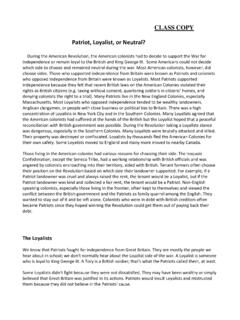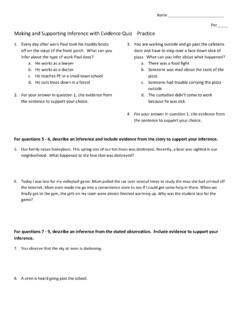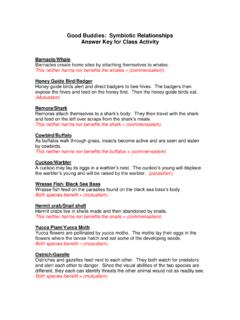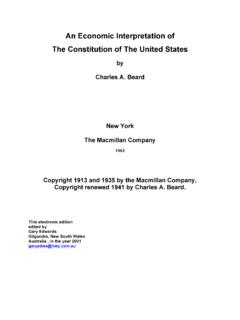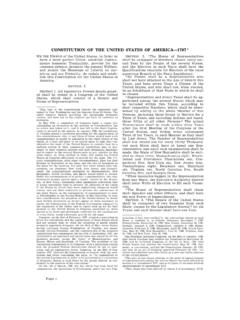Transcription of U.S. Constitution Unit Packet - Kyrene School District
1 0 Constitution Unit Packet Name_____ Period_____ 1 Learning Goal 1: Explain and analyze the principles on which the Constitution (as the Supreme Law of the Land) was founded: a. federalism ( , enumerated, reserved, and concurrent powers) b. popular sovereignty c. separation of powers d. individual rights e. checks and balances f. limited government g. flexibility ( , Elastic Clause, amendment process, living Constitution ) h. republicanism (representative democracy) 4 3 2 1 In addition to level 3, student was able to make current/historical connections when explaining and analyzing each of the principles that the Constitution was founded. Student was able to explain and analyze each of the principles that the Constitution was founded. Student was able to describe each of the principles that the Constitution was founded.
2 Student was unable to describe at least 6/8 of the principles on which the Constitution was founded. Learning Goal 2: Identify the roles, powers and qualifications of the three branches of the federal government, and explain and analyze how members of each branch are elected or appointed. a. Article 1:Legislative Branch- Congress (makes laws) - Senators elected by popular vote (17th Amendment) - Qualifications and election process for members of Congress (party primary and general elections) b. Article 2: Executive Branch- President (enforces laws) - Legacy of Washington s Presidency (Cabinet, State of the Union Address, 2 Terms- 22nd Amendment) - Electoral College and how a President is elected. (12th Amendment , and 23rd Amendment) - Qualifications to be elected President (35 yrs., Natural Born, live in for 14 years) - Presidential success (25th Amendment) - Executive Orders c. Article 3: Judicial Branch- Supreme Court (makes sure laws are constitutional) - Marbury v.
3 Madison (judicial review) - Structure of the Federal Court System ( District , Appeals and Supreme ) - Appointment to Judicial Branch by the President and approved by the Senate. d. How a bill becomes a law and checks and balances - Bill is introduced, assigned to a committee, debated and voted on, Conference Committee writes final draft, final vote in both houses, President signs or vetoes, Supreme Court checks if law is Constitutional. - Congress- Veto Override, Approves appointments to Executive branch and Supreme Court, Impeachment. - President- Appoint members in Supreme Court/ Federal Courts, call Congress into special session. - Supreme Court- Judicial Review. 4 3 2 1 In addition to level 3, student was able to make current/historical connections while identifying all the roles, powers and qualification for each of the three branches of the federal government, and explaining and analyzing how members of each branch are elected or appointed.
4 Student was able to identify all the roles, powers and qualification for each of the three branches of the federal government, and explain and analyze how members of each branch are elected or appointed. Student was able to identify all the roles, powers and qualifications for the three branches of the federal government, and how members of each branch are elected or appointed. Student was unable to identify all of the roles, powers and qualifications for the three branches of the federal government, or Identify how members of each branch are elected or appointed. 2 Learning Goal 3: Identify all ten amendments in the Bill of Rights, and explain and analyze the significance of key Supreme Court decisions in Miranda v. Arizona and Gideon v. Wainwright. a. Amendments 1-10 (Bill of Rights) - Miranda v. Arizona 5th Amendment - Gideon v. Wainright 6th Amendment 4 3 2 1 In addition to level 3, student was able to make current/historical connections when identifying all ten amendments in the Bill of Rights, and explaining and analyzing the significance of key Supreme Court decisions in Miranda v.
5 Arizona and Gideon v. Wainwright. Student was able to identify all ten amendments in the Bill of Rights, and explain and analyze the significance of key Supreme Court decisions in Miranda v. Arizona and Gideon v. Wainwright. Student was able to identify all ten amendments in the Bill of Rights and identify the Supreme Court cases of Miranda v. Arizona and Gideon v. Wainwright. Student was unable to identify all ten amendments in the Bill of Rights or the Supreme Court cases of Miranda v. Arizona and Gideon v. Wainwright. 3 Practice 1: How to Read the Constitution The Constitution is organized into 3 basic parts. -Articles -Sections -Clauses Example : Article I, Section 2, Clause 1, or I-2-1 ARTICLE I: Legislative Branch Section 1. Legislative powers; in whom vested All legislative powers herein granted shall be vested in a Congress of the united States, which shall consist of a Senate and House of Representatives. Section 2. House of Representatives, how and by whom chosen Qualifications of a Representative.
6 Representatives and direct taxes, how apportioned. Enumeration. Vacancies to be filled. Power of choosing officers, and of impeachment. 1. The House of Representatives shall be composed of members chosen every second year by the people of the several States, and the elector in each State shall have the qualifications requisite for electors of the most numerous branch of the State Legislature. 2. No person shall be a Representative who shall not have attained the age of twenty-five years, and been seven years a citizen of the united States, and who shall not, when elected, be an inhabitant of that State in which he shall be chosen. 7 Articles of the Constitution Article I- Legislative Branch (Congress) Article II- Executive Branch (President) Article III- Judicial Branch (Supreme Court) Article IV- Relations among the states Article V- How to amend (change) the Constitution Article VI- Supremacy of National Law, Oath of Office, National Debt Article VII- Ratification of the Constitution 4 Practice 1: Constitution Scavenger Hunt Directions: Use the Constitution Handbook in your American History textbook (pages 266-297) for this scavenger hunt.
7 1. What is the opening paragraph of the Constitution called? 2. Which Article deals with the Executive branch? 3. Who is the Chief Executive of the united States? 4. How many years is a term of office for the Chief Executive? 5. Give the article, section, and clause where you would find the qualifications to be Chief Executive. 6. What are the 3 qualifications of the Chief Executive? 1) 2) 3) 7. What does section 4 of Article II talk about? 8. Which part of government is established in Article III? 9. In Article III, which section and clause has the areas of original jurisdiction this court? 10. What is the definition of treason according to the Constitution ? (Article III) many Articles are there in the Constitution ? 12. Which Article talks about the Legislative branch of government? 13. What is the name of the group that holds legislative power (make laws)? 14. Name the two houses of the Legislative branch (Congress). 1) 2) 15. Which article, section and clause of the Constitution gives the qualifications to be in the House of Representatives?
8 5 16. What are the qualifications to be in the House of Representatives? 1) 2) 3) 17. Go to section 3, clause 4 of the article found in question 15 and tell who the President of the Senate is. 18. What are the qualifications to be a Senator? 1) 2) 3) 19. What is the term of office for a member of the Senate? 20 What is a term of office for a member of the House of Representatives? 21. What does Article VI deal with in general? 22. In which article, section, and clause would you look to find out about the extradition of suspected criminals? 23. At the time the Constitution was written, how many of the 13 states needed to approve of the Constitution to get it ratified? 24. Which Article tells how to amend the Constitution ? 25. What does the word amend mean? 26. How many times has the Constitution been amended? 27. Which amendment created a national income tax? 28. Which amendment outlines a citizen s right not to be searched in an unreasonable way?
9 29. What is stated in the 1st Amendment? 30. What is stated in the last (27th) Amendment 6 Practice 2: Preamble to the Constitution 7 LG 1- Principles of the Constitution Text p. 260-265 Principle What is it? Why is it important? Checks and Balances Flexibility (Living Constitution ) Federalism Individual Rights Limited Government Popular Sovereignty Separation of Powers Republicanism 8 LG 2- Article 1: Legislative Branch- Congress 9 10 11 12 LG 2- Article 1: Legislative Branch (Congress) Roles, Powers, and Qualifications to be elected to Congress - Senate (Upper House) -17th Amendment - House of Representatives (Lower House) 13 LG 2- Article 1: Legislative Branch (Congress) - Congressional Committee 14 LG 2- Article II- Executive Branch- President 15 16 LG 2- Article II- Executive Branch- President Washington s Presidency - 2 Terms/ 22nd Amendment- - State of the Union Address (speech) given to Congress each year.
10 - Cabinet- Presidential Succession/ 25th Amendment 17 Department of Homeland Security: 18 LG 2- Article II- Executive Branch- President Electing the President Text p. 276 - Electoral College: - 12th Amendment: - 23rd Amendment: - 2000 Election Bush v. Gore- Text 955-956 19 LG 2- Article III- Judicial Branch- Supreme Court Marbury v. Madison Structure of the Judicial Branch 20 21 22 LG 2- Checks and Balances. Create a thinking map of your choice showing how the three branches of Federal Government Check and Balance each other s power- American History Text p. 281 23 24 25 LG 2 How a bill becomes a law Create a flow map showing the process of how a bill becomes a law. Text Page 271 26 LG 3- Bill of Rights- Create a brace map to summarize the information you read about the first ten amendments to the Constitution (Bill of Rights).





